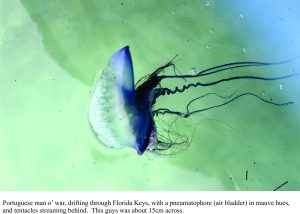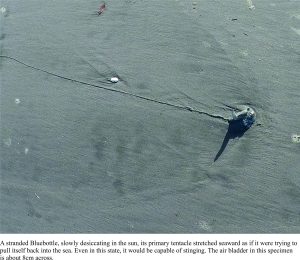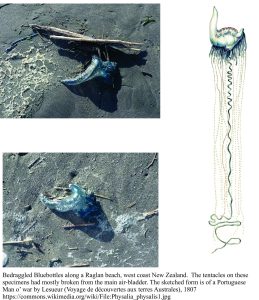
The southern hemisphere is coming into summer; it’s done this every year for as long as I can remember. For New Zealanders, and pretty well anyone else in this ocean-locked hemisphere there is an exodus, a migration as the population ups-sticks and heads to the beach. Unlike our nearest neighbour, we are not thwarted by crocs, sea snakes, Stone Fish or Box Jellyfish; Great Whites mostly ignore us. From the point of view of dastardly critters, these shores would be considered benign. Except for Bluebottles.
Bluebottles galore; entanglements that can ruin a perfect day at the beach (soft, squishy and potentially dangerous). There are thousands of Bluebottle stings reported every year in New Zealand and Australia. Bluebottles are related to jellyfish, a very pretty blue, puffed up balloon-like, stranded along the high tide line, bedraggled. These creatures, delicately laced, frequently litter NZ beaches (and elsewhere), blown ashore on the tide.
Bluebottles belong to a group of marine animals (a phylum) called Cnidarians, a group that includes corals, sea anemones, true jellyfish, and siphonophores. They all have stinging cells (nematocysts), although corals, sea anemones and many jellyfish tend to be relatively benign – except to the small critters they like to eat.
Bluebottles are not Jellyfish, they are siphonophores. A true Jellyfish is a single organism, a medusa that possesses a central gut and nervous system; they are all free swimming (Sea Anemones also are single organisms, consisting of a polyp attached to rock, shell or sediment). Bluebottles are colonial organisms containing a myriad, microscopic, multicellular animals, or zooids, that find solace in community living. Despite being individuals, zooids are attached to and dependent on each other. Zooids tend to have specialized functions; some are attuned to digestion, others to swimming or carrying stinging nematocysts in their tentacles .

The two most common species are Bluebottles that inhabit the Pacific and Indian oceans (the species Physalia utriculus), and the Atlantic (Physalia physalis), the latter more commonly known as the Portuguese Man o’ War (see image at the top of this post). Both have an easily identifiable gas-filled bladder (pneumatophore) in an attractive blue with hints of mauve, from which dangle tentacles – the things that do the damage to passing small fish and people. The bladders provide the only means for movement by catching wind and waves (again, unlike Jellyfish that propel themselves).

Portuguese Men o’ War (or Portuguese Man o’ Wars, depending on your preference) tend to be larger than their Pacific cousins, with tentacles extending 10m, and even 30m below the sea surface. Bluebottles have smaller pneumatophores, and fewer and shorter tentacles. The tentacles contain many stinging cells called nematocysts; their sole function is to catch and stun prey. Nematocysts on Bluebottles and Portuguese Men of War can penetrate skin to inject venom. A single stinging cell will do little damage. Unfortunately, tentacles tend to wrap their prey (including arms and legs), in an act of evolutionary hubris that inflicts multiple stings manifested in a nicely symmetrical, cork-screw like pattern of welts.
Bluebottle stings are painful- I can attest to this. In most people, this is as far as it goes, but if you are unfortunate to have tentacles wrapped around large areas of your semi-naked body, the venom can induce nausea and headaches, and in more serious cases, difficulty breathing or cardiovascular failure (happily the latter are rare).
There is plenty of advice on how to deal with Bluebottle and Portuguese Man o’ War stings. First and foremost, don’t try to rub or scrape off the tentacles; this will only exacerbate envenomation. Use seawater to wash thoroughly the affected area. Some authorities recommend dabbing vinegar on the welts to help ease the pain; others suggest this only makes matters worse (this link is an Open Access document). I must admit, a bottle of vinegar is not usually on my list of things to take to the beach, unless I’m planning to cook shellfish.
There is also the mistaken belief that peeing on the affected area will help. Urinating on oneself might be awkward, so you would probably need a willing accomplice. But the real kicker here is that urine makes the nematocysts release more venom. So, if anyone suggests this remedy, do let them know it is nonsensical, notwithstanding the public spectacle. Tentacles can also release venom long after they have been blown ashore. So it’s best to admire them from a distance.
Enjoy summer.

















